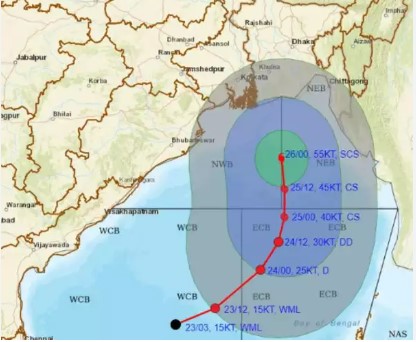Context:
The Indian Meteorological Department (IMD) recently said that over the southwest and the nearby west-central Bay of Bengal, a low-pressure region (cyclone), which would be named Remal was developed.
More on the news:
- According to IMD, the storm can further intensify into a depression and move northeast.
- Additionally, the Joint Typhoon Warning Centre (JTWC) of the US Navy also issued a warning regarding a depression in the Bay of Bengal.
- The US Global Forecasting System (GFS), forecast suggests cyclone Remal may form on the morning in the northwest Bay of Bengal and approach West Bengal and Bangladesh coasts.
- According to The Weather Channel (TWC), the possibility of a cyclone forming does exist, but the chances of it intensifying into a severe or very severe cyclonic storm are low.

Cyclone
- Cyclone, any large system of winds that circulates about a center of low atmospheric pressure in a counterclockwise direction north of the Equator and in a clockwise direction to the south.
Conditions for Tropical Cyclone Formation
- Sea Surface Temperature higher than 27 degrees Celsius.
- Presence Of Coriolis Force
- Small Variations in vertical wind
- Weak low-pressure Present
- Upper Divergence
How come the name “Remal”?
- The World Meteorological Organization (WMO) decided in 2020 to compile a list of names for tropical cyclones that occur in the North Indian Ocean, which is made up of the Arabian Sea and the Bay of Bengal.
- That year, a list of 169 cyclone names was provided by the Indian Meteorological Department (IMD).
- The list indicates that ‘Remal’ will be the name given to the current cyclonic circulation in the Bay of Bengal if it intensifies into a cyclone.
Potential Impact of the Cyclone:
- The IMD predicted that there would be widespread light to moderate rainfall, with sporadic heavy rainfall over the districts of North and South 24 Parganas, Purba Medinipur in West Bengal, and Balasore in Odisha.
- Mizoram, Tripura, and south Manipur all have received similar forecasts from IMD.

